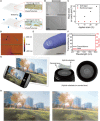Soft, smart contact lenses with integrations of wireless circuits, glucose sensors, and displays
- PMID: 29387797
- PMCID: PMC5787380
- DOI: 10.1126/sciadv.aap9841
Soft, smart contact lenses with integrations of wireless circuits, glucose sensors, and displays
Abstract
Recent advances in wearable electronics combined with wireless communications are essential to the realization of medical applications through health monitoring technologies. For example, a smart contact lens, which is capable of monitoring the physiological information of the eye and tear fluid, could provide real-time, noninvasive medical diagnostics. However, previous reports concerning the smart contact lens have indicated that opaque and brittle components have been used to enable the operation of the electronic device, and this could block the user's vision and potentially damage the eye. In addition, the use of expensive and bulky equipment to measure signals from the contact lens sensors could interfere with the user's external activities. Thus, we report an unconventional approach for the fabrication of a soft, smart contact lens in which glucose sensors, wireless power transfer circuits, and display pixels to visualize sensing signals in real time are fully integrated using transparent and stretchable nanostructures. The integration of this display into the smart lens eliminates the need for additional, bulky measurement equipment. This soft, smart contact lens can be transparent, providing a clear view by matching the refractive indices of its locally patterned areas. The resulting soft, smart contact lens provides real-time, wireless operation, and there are in vivo tests to monitor the glucose concentration in tears (suitable for determining the fasting glucose level in the tears of diabetic patients) and, simultaneously, to provide sensing results through the contact lens display.
Figures





References
-
- Tee B. C.-K., Chortos A., Berndt A., Nguyen A. K., Tom A., McGuire A., Lin Z. C., Tien K., Bae W.-G., Wang H., Mei P., Chou H.-H., Cui B., Deisseroth K., Ng T. N., Bao Z., A skin-inspired organic digital mechanoreceptor. Science 350, 313–316 (2015). - PubMed
-
- Kim J., Salvatore G. A., Araki H., Chiarelli A. M., Xie Z., Banks A., Sheng X., Liu Y., Lee J. W., Jang K.-I., Heo S. Y., Cho K., Luo H., Zimmerman B., Kim J., Yan L., Feng X., Xu S., Fabiani M., Gratton G., Huang Y., Paik U., Rogers J. A., Battery-free, stretchable optoelectronic systems for wireless optical characterization of the skin. Sci. Adv. 2, e1600418 (2016). - PMC - PubMed
-
- Park S. I., Brenner D. S., Shin G., Morgan C. D., Copits B. A., Chung H. U., Pullen M. Y., Noh K. N., Davidson S., Oh S. J., Yoon J., Jang K.-I., Samineni V. K., Norman M., Grajales-Reyes J. G., Vogt S. K., Sundaram S. S., Wilson K. M., Ha J. S., Xu R., Pan T., Kim T.-i., Huang Y., Montana M. C., Golden J. P., Bruchas M. R., Gereau R. W. IV, Rogers J. A., Soft, stretchable, fully implantable miniaturized optoelectronic systems for wireless optogenetics. Nat. Biotechnol. 33, 1280–1286 (2015). - PMC - PubMed
-
- Wang C., Hwang D., Yu Z., Takei K., Park J., Chen T., Ma B., Javey A., User-interactive electronic skin for instantaneous pressure visualization. Nat. Mater. 12, 899–904 (2013). - PubMed
Publication types
MeSH terms
Substances
LinkOut - more resources
Full Text Sources
Other Literature Sources
Medical

